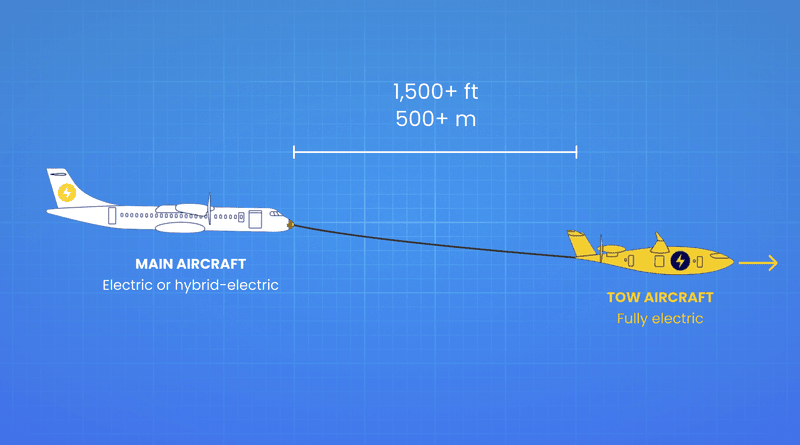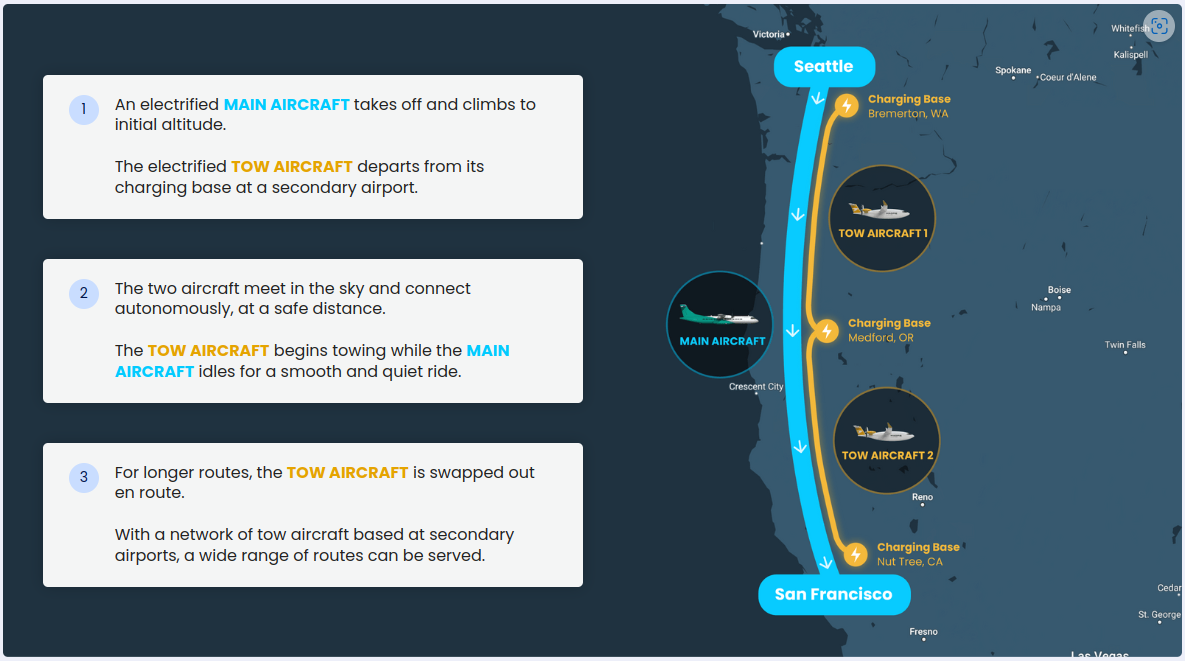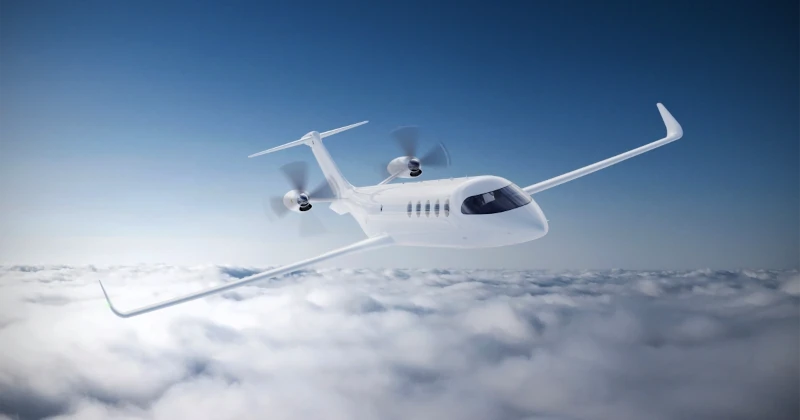Low-Altitude Economy | Urban Air Mobility | eVTOL | Low Altitude Mobility

Beyond Batteries: How Aero towing Unlocks New Horizons for Electric Aircraft
Magpie Aviation is developing a transformative solution in electric aircraft technology, introducing an aero-towing system designed to significantly extend the range of electric aircraft flights, a critical step toward achieving commercially feasible electric aircraft transportation. This initiative aims to tackle one of the most pressing challenges facing electric and hydrogen-powered aircraft today: their limited range due to the current state of battery technology, without sacrificing the payload capacity critical for commercial viability.
The heart of Magpie's innovation lies in its unique aero-towing system. This system achives an extended flight range by tethering electric passenger or cargo aircraft to a specially designed all-electric tow aircraft after takeoff. This method not only leverages the principle of aero towing, which has a rich heritage in aviation, mainly with gliding but also repurposes it for the modern era of electric flight, marking a significant advancement toward Magpie's sustainable aviation goals.

Imagine a scenario where an electric passenger aircraft, designed for regional travel and operating with current battery technology, is scheduled for a flight from San Francisco to Seattle, roughly 800 miles. Traditionally, the range limitations of electric aircraft would make this route difficult without stopping for a recharge, potentially making the journey impractical for commercial use.
Enter Magpie Aviation's aero-towing system. Here is how it transforms this scenario:
- Pre-flight Preparation: Before takeoff, the electric passenger aircraft, the main aircraft, communicates with a dedicated electric tow aircraft. This tow aircraft is specially designed with high-capacity batteries and optimized for efficient, high-altitude towing.
- Takeoff and Initial Climb: The main aircraft takes off using its own power, climbing to an initial altitude. Meanwhile, the tow aircraft departs from a nearby secondary airport equipped with charging facilities.
- Mid-air Rendezvous and Connection: Once both aircraft reach a predetermined altitude and location, they autonomously connect using an advanced tethering system. This system ensures a secure and stable link, with the tow aircraft taking on the primary propulsion role.
- Towed Flight to Destination: The main aircraft idles its engines while the tow aircraft pulls it, allowing for a quiet, efficient journey that significantly extends the main aircraft's range without using its battery reserves. This towing phase can cover the bulk of the journey, showcasing the system's potential to extend electric flight ranges dramatically.
- Disconnection and Landing: As the aircraft approach Seattle, they disconnect, allowing the main aircraft to use its preserved battery power for the final approach and landing. The towing aircraft returns to its base or connects with another aircraft needing a recharge.

This connection assists in the aircraft's climb to cruising altitude, with subsequent phases aiming to enable a tow vehicle to pull the aircraft at high speeds for distances up to 300 miles on a single charge. Ultimately, Magpie envisions a network of electric tow aircraft strategically positioned to facilitate multiple aero tow stages for flights extending beyond 1,000 miles.
Magpie Aviation's aero-towing concept exemplifies an innovative approach to overcoming current barriers in electric aircraft, providing a tangible solution to extend the reach of sustainable flights. By enabling electric aircraft to undertake longer routes efficiently and without sacrificing payload capacity, aero-towing holds promise for a cleaner, more sustainable future in air travel.
The envisioned operational framework ensures the towed aircraft maintains sufficient power reserves for takeoff, landing, and diversion to alternate airports if necessary. This meticulous planning underscores the safety and reliability at the core of Magpie's approach, ensuring that these aspects remain paramount in this technological advancement.
Aero-towing has a rich history in aviation, particularly within the gliding community. However, Magpie's vision expands this application to encompass many aircraft, including electric passenger and cargo planes. Initially, the process would involve an electric passenger or cargo aircraft autonomously connecting to an electric tow aircraft post-takeoff.
Magpie's CEO, Damon Vander Lind, notes that while the idea may seem unconventional, extensive deliberation and feasibility studies have reinforced their commitment to this innovative approach. The concept's versatility also means it could be adapted to hybrid and hydrogen-powered aircraft or even conventional aircraft capable of operating in a low-power mode, thereby broadening its applicability across the aviation industry.
The potential benefits of this aero-towing system go beyond environmental sustainability. By enabling electric aircraft to undertake longer flights without the need for significantly larger batteries or compromising payload, Magpie's approach could also boost the economic viability of all electric aircraft.
Given the relatively high efficiency and lower operational costs associated with electric aircraft flight, overcoming the current range limitations could expedite the industry's transition toward a greener future.

Magpie plans to scale up its aero tow system progressively. The company envisions that by 2030, regional turboprop-sized aircraft could be towed in regular commercial service by electric tow aircraft. This ambitious timeline reflects the urgency of aviation's environmental challenges and the potential of Magpie's technology to contribute to a solution. Advances in battery technology are expected to enhance the system's capabilities further, expanding its applicability to larger transport aircraft over time.
Current Limitations of Battery Technology: Electric aircraft primarily rely on battery technology for power, which, despite rapid advancements, still needs to improve in energy density compared to traditional aviation fuels. This disparity means electric aircraft have restricted range and payload capabilities because batteries still need to offer the same efficiency level as liquid fuels in terms of energy per unit weight. Aero towing partially mitigates these limitations by extending range without needing larger battery packs. However, the success of this system is still inherently tied to future improvements in battery technology to ensure that the tow and main aircraft can operate effectively and efficiently.
Potential Costs and Logistical Challenges: Implementing Magpie's aero-towing system broadly introduces potential costs and logistical complexities. Establishing a fleet of electric tow aircraft requires significant capital investment in the aircraft and the infrastructure needed to support them, including charging stations at secondary airports and maintenance facilities. Additionally, the operational logistics of coordinating tow aircraft with passenger or cargo flights introduce new layers of complexity in flight scheduling and airspace management to ensure safety and efficiency.
Regulatory Hurdles: Another challenge lies in navigating the regulatory landscape. Introducing a novel aero towing system for commercial purposes will require extensive certification processes to meet safety standards set by aviation authorities such as the FAA or EASA. These processes can be lengthy and costly, requiring detailed testing and validation of the technology under various conditions to prove its reliability and safety.
Despite these challenges, the promise of Magpie Aviation's aero-towing technology for sustainable aviation is undeniable. Addressing the limitations above through ongoing research, development, and collaboration with regulatory bodies and industry stakeholders is crucial. As battery technology advances and the aviation industry continues to prioritize sustainability, aero-towing has the potential to play a pivotal role in the transition to zero-emission air travel, offering a novel solution to one of the industry's most pressing challenges.


